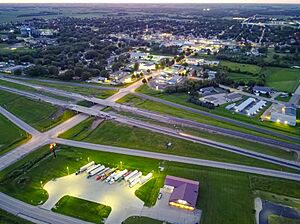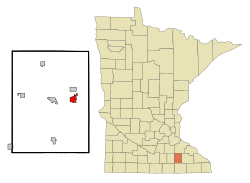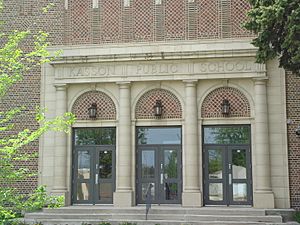Kasson, Minnesota facts for kids
Quick facts for kids
Kasson
|
|
|---|---|

US-14 and MN-57 junction in town
|
|
| Motto(s):
"We're Ready For You"
|
|

|
|
| Country | United States |
| State | Minnesota |
| County | Dodge |
| Area | |
| • Total | 3.04 sq mi (7.88 km2) |
| • Land | 3.04 sq mi (7.88 km2) |
| • Water | 0.00 sq mi (0.00 km2) |
| Elevation | 1,263 ft (385 m) |
| Population
(2020)
|
|
| • Total | 6,851 |
| • Density | 2,252.88/sq mi (869.96/km2) |
| Time zone | UTC-6 (Central (CST)) |
| • Summer (DST) | UTC-5 (CDT) |
| ZIP code |
55944
|
| Area code(s) | 507 |
| FIPS code | 27-32498 |
| GNIS feature ID | 2395495 |
| Website | www.cityofkasson.com |
Kasson (pronounced KASS-ən) is a city in Dodge County, Minnesota, United States. It's a friendly place with a motto that says, "We're Ready For You."
In 2020, about 6,851 people lived in Kasson. The city is located about 13 miles (21 km) west of Rochester. Important roads like U.S. Highway 14 and Minnesota State Highway 57 pass through Kasson. A main freight train line also runs through the city. Kasson shares a school system with nearby Mantorville, and their sports teams are known as the "K–M Komets."
Contents
History of Kasson
Kasson officially became a city on February 24, 1870. It was named after Jabez Hyde Kasson, who owned the land where the town was built. Jabez Kasson was born in 1820 and moved to Minnesota in 1856.
He helped plan the village along with others. The plan for the town was officially recorded on October 13, 1865. Kasson also had a train station, and its post office opened in 1866.
Where is Kasson Located?
Kasson covers a total area of about 3 square miles (7.8 square kilometers), and all of it is land. It is located about 15 miles (24 km) west of Rochester. The city is also just 3 miles (4.8 km) south of Mantorville.
Kasson's Population Over Time
Kasson has grown quite a bit over the years. Here's how its population has changed:
| Historical population | |||
|---|---|---|---|
| Census | Pop. | %± | |
| 1870 | 515 | — | |
| 1880 | 1,054 | 104.7% | |
| 1890 | 992 | −5.9% | |
| 1900 | 1,112 | 12.1% | |
| 1910 | 932 | −16.2% | |
| 1920 | 1,150 | 23.4% | |
| 1930 | 1,019 | −11.4% | |
| 1940 | 1,230 | 20.7% | |
| 1950 | 1,353 | 10.0% | |
| 1960 | 1,732 | 28.0% | |
| 1970 | 1,883 | 8.7% | |
| 1980 | 2,827 | 50.1% | |
| 1990 | 3,514 | 24.3% | |
| 2000 | 4,398 | 25.2% | |
| 2010 | 5,931 | 34.9% | |
| 2020 | 6,851 | 15.5% | |
| U.S. Decennial Census | |||
People Living in Kasson (2010)
In 2010, there were 5,931 people living in Kasson. Most of the people were White (96.0%). About 4.2% of the population identified as Hispanic or Latino.
There were 2,224 households in the city. Many households (41.3%) had children under 18 living with them. The average household had about 2.65 people. The average family had about 3.18 people.
The average age of people in Kasson was 33.1 years old. About 31.3% of residents were under 18. About 11.3% were 65 years or older. There were slightly more females (51.4%) than males (48.6%) in the city.
Historic Kasson Public School
The old Kasson Public School building, built in 1918, is a very important part of the city's history. Thanks to a local group called Kasson Alliance for Restoration (KARE), this building is now on the National Register of Historic Places. This means it's recognized as a special historic site.
Students first started using this grand school building on December 5, 1918. Its approval for the National Register happened almost 89 years later, on December 6, 2007.
The Kasson Public School building joins other historic places in Kasson on this list. These include the Jacob Leuthold Jr. House, the Eureka Hotel, the Kasson Municipal Building, and the Kasson Water Tower.
People in Kasson have thought about what to do with the old school building. A study was done to find new ways to use it. Many citizens responded to a survey, and 58% of them wanted to fix up and reuse the school. However, the building is still empty today.
Kasson's Annual Festival in the Park
Kasson is famous for its yearly "Festival in the Park" celebration. This fun event happens every August and is organized by volunteers. It's a weekend full of activities that celebrate the town's history and bring everyone together.
The festival started in 1991 and has grown bigger each year. It includes traditional events like a parade and a fireworks show. The "Miss Kasson" ceremony recently changed to "Kasson Ambassador," so boys can now take part too! More recent events include a bellyflop contest, an eating contest, and a musical showcase. The festival takes place on the second weekend of August every year at North Park.
Famous People from Kasson
- Philip S. Duff: A Minnesota state lawmaker and newspaper editor.
- Alfred M. Falkenhagen: A Minnesota state lawmaker and farmer.
- Peg Lynch: A radio and early television star who grew up in Kasson.
See also
 In Spanish: Kasson (Minnesota) para niños
In Spanish: Kasson (Minnesota) para niños



